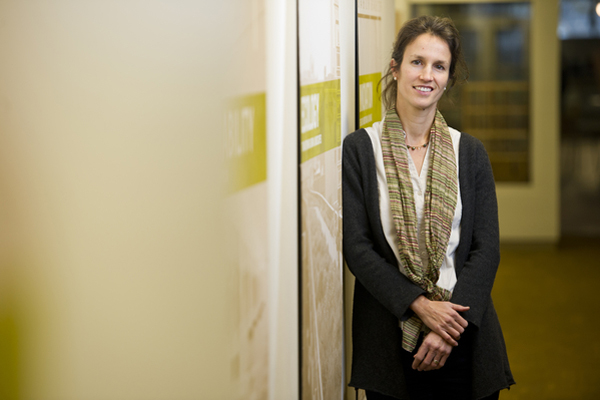3Qs: How cities prepare for the next Sandy

Several weeks after Hurricane Sandy made landfall on the East Coast, the devastation is still being felt — particularly in hard-hit sections of New York and New Jersey. The storm has also raised questions about how major cities can prepare for the next major weather event of its kind. Jane Amidon, professor of architecture and director of the urban landscape program in the College of Arts, Media and Design, looks at what urban design lessons can be learned from Hurricane Sandy, and why researchers must take an interdisciplinary approach to preparing for another natural disaster.
What did Hurricane Sandy teach us about the design and redesign of cities?
For a long time, we’ve thought about form in urban design but we’ve become increasingly focused on the environmental performance of cities. “Green” and “blue” infrastructure like urban forests and “soft” rather than “hard” waterfronts edges double as scenic and recreation zones, urban habitat and alternative transportation such as bikeways. Living systems such as wetlands, estuaries and flood plains help protect urban centers by helping detain and absorb storm water and provide filtration to reduce the amount of contaminants being dispersed following floods. These are all measurable benefits for society.
During Hurricane Sandy, one reason why the East River’s water rise was so damaging to lower Manhattan and Brooklyn was because the tidal surge coming through Long Island Sound had nowhere to go but into streets and tunnels. There was very little green infrastructure in place to provide these critical ecological services. Today, there is only a fraction of the hundreds of thousands of acres of floodplains and wetlands New York’s metro region once had. We need to design working ecologies back into our cultural spaces, which is a very complex process environmentally, financially and socially.
Your expertise lies in the design of urban environments. Can you explain how this field relates to climate change and responding to the increasing frequency and strength of storms like Sandy?
The field of urban landscape stems from the professional disciplines of urban design, landscape architecture and planning and is deeply influenced by the environmental sciences and the arts. Contemporary landscape-urbanism or ecological-urbanism theory positions cities as dynamic, adaptive organisms rather than static entities. The intersection of changing environmental and economic paradigms on a global level points to sustainability as an all-encompassing agenda for 21st-century cities.
In response to extreme weather events such as Hurricanes Sandy and Irene and to economic events such as the 2008 recession, design professionals increasingly use a “telescopic” perspective to combine systems-scale research and analysis with local intervention. Of primary interest is how designers create frameworks for change by shaping land-use strategies and designing environments that can be phased in over decades instead of with singular master plans. This is due in part to the fact that urban projects are becoming increasingly complex and respond to issues that can’t be answered in one generation or budget cycle.
How can taking an interdisciplinary approach be effective in addressing these issues?
The scope of questions in the built environment calls for collaboration between design, policy, engineering, environmental science and technology. In urban environmental design, for instance, we work frequently with practitioners and researchers in public health, law, business and related disciplines.
A major component of our curriculum in the School of Architecture is the design studio, which is a hands-on educational laboratory for exploring and applying ideas to real-world conditions. We try to bring in studio instructors and studio critics with a broad range of interests and practical experience so that our students are exposed to interdisciplinary thinking. We are developing degree options like the half-major and cross-college masters programs that allow students to customize their education by hybridizing design with other fields. Our co-ops and Berlin study abroad program place students in a range of interdisciplinary environments. Essentially, we hope to prepare our students to be innovative design thinkers.




